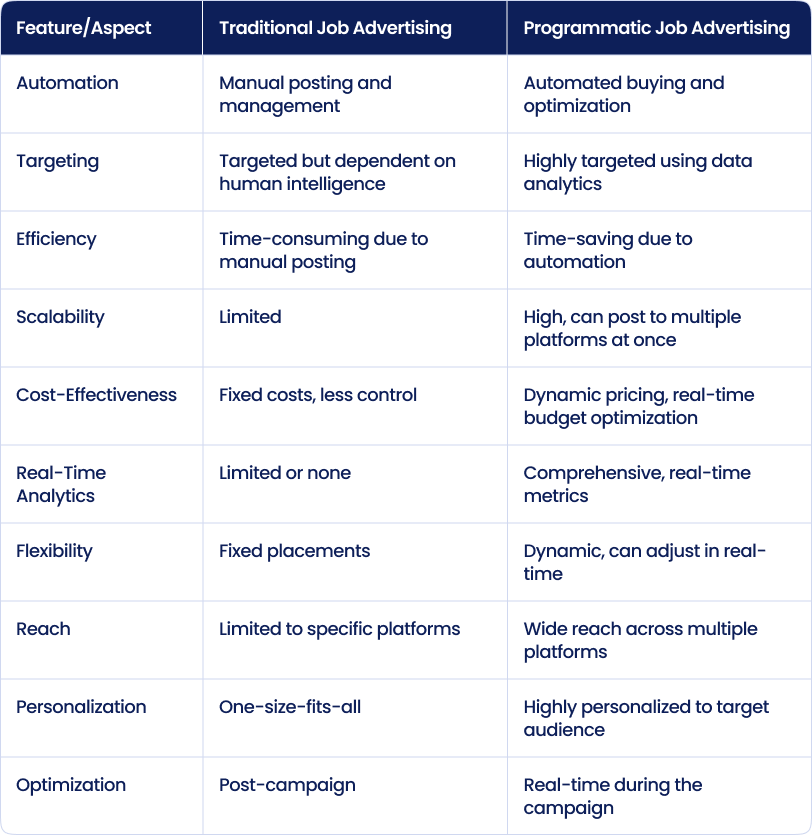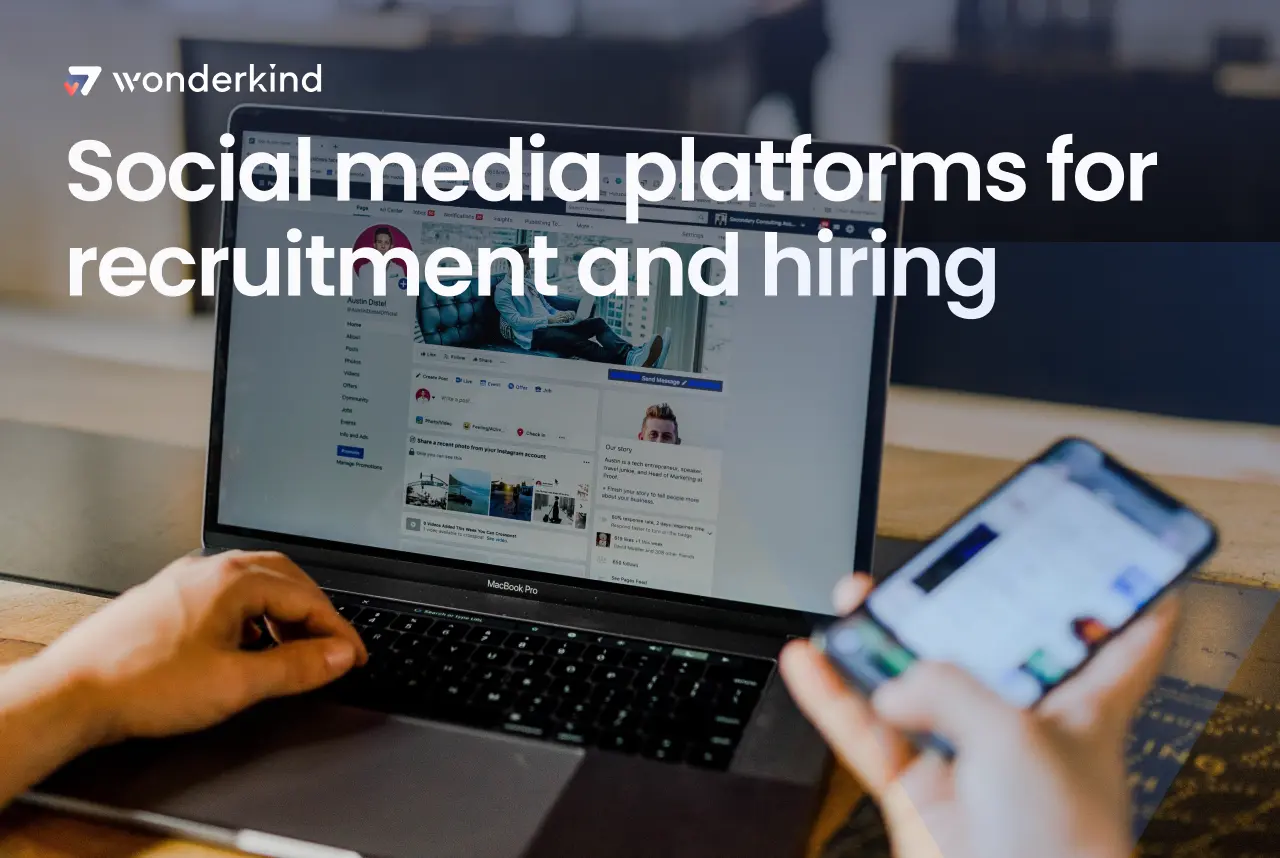Programmatic job advertising: Full guide (2024)
Performance marketers, CMOs, project managers: are you ready to unlock the full potential of your job advertising? Let's get into the nitty-gritty of programmatic job advertising.

Performance marketers, CMOs, project managers, and everyone shaping the future of talent attraction, are you ready to unlock the full potential of your job advertising? Let's get into the nitty-gritty of programmatic job advertising.
What is programmatic job advertising?
Programmatic job advertising is the automated process of buying and selling job ad placements online. This real-time transaction occurs through an automated system known as a Demand Side Platform (DSP).
This approach allows recruiters and hiring agencies to disseminate job ads across multiple platforms with minimal human intervention.
To paint a clearer picture, let's contrast traditional job advertising with programmatic job advertising. In the traditional model, you'd reach out to a job board or a social media platform and request their “rate card”.
After reviewing the options, you'd select the one that aligns with your budget and objectives. Your job ad would then run for a set period, and if you wish to extend its duration, you'd have to manually contact your account manager to renew the contract.
In the world of programmatic job advertising, all these manual steps are eliminated. You design a single job ad, register on a programmatic job advertising platform, specify your target audience, and let the technology handle the rest.
The platform's algorithms ensure your job ads reach the most relevant candidates, optimising your spend and saving you time in the process.
This concept has been a cornerstone in the ecommerce industry for years, helping d target customers with personalised ads to boost sales and engagement.
The ABCs of programmatic job advertising
Programmatic job advertising automates the process of placing job ads across a wide array of platforms, for instance, to recruit on social media. This enables you to showcase your job openings on multiple websites and social media channels in an instant.
Algorithms play a key role here, gathering data to display job ads that align with the candidate's profile and interests.
It's important to note that as regulations limit targeting options on social media platforms, the creative content in your ads is becoming increasingly vital.
The platforms we support use these creatives to help their algorithms determine who should see your ad. In other words, the visuals and messaging in your ads are not just for show; they're now a critical component for effective targeting.
Let's illustrate with a practical example. Imagine you're a staffing agency aiming to fill tech roles for a client. You initiate your programmatic job ad campaign via a Demand Side Platform (DSP).
In the DSP, you specify your target audience (or the DSP will do it for you automatically):
- Demographics: Such as age ranges and gender.
- Device: Desktop, mobile, or tablets.
- Interests: Areas like coding, data science, and cloud computing.
- Behaviours: For example, regularly engaging with tech blogs or attending webinars.
The DSP uses this data to target candidates who are a good fit for these tech roles. It then engages in real-time bidding (RTB) to secure ad spaces on relevant websites and platforms.
Once your ad starts winning bids, you'll have access to key performance indicators—click-through rates, impressions, and application numbers.
From the job seeker's perspective, let's consider a software developer interested in cloud computing and a regular reader of tech blogs.
They may not be actively seeking a new role, but when they encounter your well-targeted and creatively designed ad for a Cloud Developer position, they are compelled to click and explore further.
In summary, programmatic job advertising is an intelligent, automated way to find your ideal candidate, and its effectiveness is increasingly enhanced by the quality of creative content.
What are the benefits of programmatic job advertising?
When looking at the benefits of programmatic job advertising, we can identify a few specific categories: efficiency, scale, targeting and cost-effectiveness. Here's the drill-down of each of these.
Efficiency
Automation eliminates the manual labor of posting job ads, allowing you to focus on higher-value tasks. This is a game-changer in a tight labor market where every second counts.
Scale
Imagine being able to post to multiple job boards, social media platforms, and niche sites at the click of a button. That's the power of scale, and it's how you reach both active and passive candidates.
Targeting
Advanced algorithms analyse data points from skills to browsing behaviour, allowing you to target your ideal candidates with laser precision. This is crucial for reaching passive candidates who aren't actively looking but are open to new opportunities.
Cost-effectiveness
Real-time analytics enable you to adjust your campaigns on the fly, ensuring you're not throwing money down the drain. You can optimise your cost-per-application (CPA) and cost-to-hire, getting more value for your ad spend.
In today's fast-paced, competitive labor market, programmatic job advertising isn't just an option; it's a necessity. It's the Swiss Army knife in your Talent Attraction toolkit, offering unparalleled efficiency, scale, targeting, and cost-effectiveness.
Frank Nijmeijer, CCO Wonderkind
On which platforms can you use programmatic job advertising?
You can employ programmatic job advertising on several different platforms, the main ones being: Facebook, LinkedIn, Instagram and the Google Display Network. Each of these have their own specific characteristics and benefits.
Excellent for reaching a broad demographic. Its robust targeting options make it especially good for reaching passive candidates who aren't actively job hunting but could be interested in the right opportunity.
The go-to platform for professional networking. It's ideal for roles requiring specific skills or qualifications and offers a more business-focused environment for your ads.
Highly visual and popular among younger demographics. It's perfect for roles in creative or tech-savvy industries where visual storytelling can make a big impact.
Google Display Network
Allows you to reach candidates across a wide range of websites they frequently visit, from news sites to blogs and more, making your ads more omnipresent.
Performance-based job boards and aggregators
These platforms are designed to maximise the visibility of your job ads based on performance metrics, offering another avenue to reach your target audience.
Traditional job advertising vs programmatic job advertising
Most companies still rely on the "post & pray" method, promoting their jobs on a fixed set of media channels like Indeed and LinkedIn. This approach lacks the flexibility and data-driven decision-making that programmatic advertising offers.
Traditional job advertising
Typically involves manually posting jobs on job boards or advertising platforms. Each post is a separate transaction, and there's limited scope for real-time optimisation. It's essentially a one-size-fits-all approach that doesn't consider the unique needs and behaviors of different candidate pools.
Programmatic job advertising
Automates the ad buying process, allowing for real-time adjustments and data-driven decision-making. It's not just about posting a job; it's about posting the right job to the right audience at the right time.
This approach leverages data to make informed decisions, allowing for more personalised and effective campaigns.
This table below should give you a quick yet comprehensive look at why programmatic job advertising has the edge, especially in a tight labor market.
It's all about being more efficient, targeted, and adaptable to get the talent you need.

How do you get started with programmatic job advertising?
1. Set clear goals and objectives
Start with the end in mind. Whether it's increasing brand awareness, driving traffic to career pages, or boosting the number of quality applications, your goals will dictate your strategy.
2. Figure out your target audience
Use analytics tools to dig deep into your ideal candidate's profile. What are their skills, career aspirations, and even their online behaviour? The more you know, the better you can target.
3. Choose the right software
Here's where you need to be picky. Look for platforms that offer the ability to distribute audio-visual job ads at scale. This is how you stand out in a crowded, scrolling world. Platforms like Wonderkind offer this unique feature, setting you apart from competitors who focus on single job ad distribution.
4. Set your budget and bid strategy
Budgeting goes beyond merely setting a financial limit; it's about strategically allocating your resources for maximum impact. With flexible options like pay-per-click (PPC) and real-time bidding, you have the ability to fine-tune your strategy to achieve optimal results. Various commission rates apply, allowing you to tailor your approach to your specific needs.
5. Monitor your campaigns and keep optimising
Programmatic advertising isn't a "set it and forget it" game. Use real-time analytics to continually refine your campaigns. Look at metrics like CPA, cost-to-hire, and engagement rates to understand what's working and what needs tweaking.
Some programmatic recruitment advertising terms you should know
It's easy to get lost in the jungle of programmatic recruitment lingo out there, so we wanted to give you a short teardown of some of the most important terms and abbreviations.
Pay-per-click (PPC)
You pay a fee each time someone clicks on your ad. This is a common bidding strategy in programmatic advertising.
Cost-to-hire
This is the total cost involved in hiring a new employee, from the initial ad spend to the final onboarding process.
Cost-per-application (CPA)
This metric tells you how much you're spending for each application received. It's a key indicator of your campaign's effectiveness.
Real-time bidding
This is a live auction environment where ad impressions are bought and sold in real-time, often in milliseconds.
Demand-side platform (DSP)
This is the software that allows you to manage multiple ad exchange accounts through one interface. It's your command center for programmatic advertising.
Supply-Side Platforms
On the flip side, job boards, career platforms, and social media sites use Supply-Side Platforms to make their digital real estate available for job ad placements and bidding.
This includes not only traditional job listing sites and specialised industry forums but also social media platforms that offer a diverse and dynamic user base.
Through algorithms and data analytics, these platforms can serve highly targeted job ads to both active and passive job seekers.
This allows recruiters and hiring agencies to tap into a wide-ranging pool of potential candidates, making Supply-Side Platforms an integral part of the programmatic job advertising ecosystem.
The best approach to programmatic job advertising
When it comes to getting started with programmatic job ads, you can following these 4 simple steps:
1. Start small
Test different programmatic job ad platforms, types of content, and targeting options. Use A/B testing to refine your approach.
2. Scale smartly
Once you've identified what works, scale up. This is where platforms that can distribute ads at scale offer a significant advantage.
3. Be creative
Use audio-visual content to make your ads pop. In a world of endless scrolling, a compelling video or eye-catching graphic can make all the difference.
4. Iterate
Continuously analyse your campaigns. Use data to refine your targeting, tweak your bidding strategy, and optimise your ad creative.
Programmatic job advertising software you should try
- Wonderkind: Ideal for those who want to distribute compelling audio-visual job ads at scale. We're not just tooting our own horn; we genuinely offer something unique in the market.
- Adway: A solid choice that has been making remarkable progress lately. However, their primary focus remains on single job ad distribution.
- Appcast: Particularly successful in the U.S. and U.K. markets, Appcast focuses primarily on job boards and aggregators.
So there you have it—a comprehensive, in-depth guide to programmatic job advertising.
Ready to dive in? Let's revolutionise the Talent Attraction landscape, one automated, data-driven ad at a time!
Want to learn more about our Talent Attraction Technology?
Make more placements while keeping a clear overview of costs and ROI.



